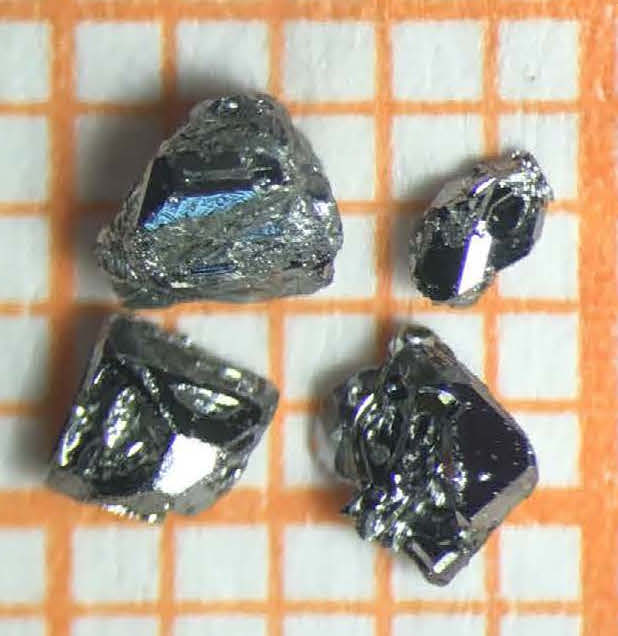Nowotny phase on:
[Wikipedia]
[Google]
[Amazon]

 In inorganic chemistry, a Nowotny chimney ladder phase (NCL phase) is a particular
In inorganic chemistry, a Nowotny chimney ladder phase (NCL phase) is a particular

 In inorganic chemistry, a Nowotny chimney ladder phase (NCL phase) is a particular
In inorganic chemistry, a Nowotny chimney ladder phase (NCL phase) is a particular intermetallic
An intermetallic (also called an intermetallic compound, intermetallic alloy, ordered intermetallic alloy, and a long-range-ordered alloy) is a type of metallic alloy that forms an ordered solid-state compound between two or more metallic eleme ...
crystal structure
In crystallography, crystal structure is a description of the ordered arrangement of atoms, ions or molecules in a crystalline material. Ordered structures occur from the intrinsic nature of the constituent particles to form symmetric patterns ...
found with certain binary compound
In materials chemistry, a binary phase or binary compound is a chemical compound containing two different elements. Some binary phase compounds are molecular, e.g. carbon tetrachloride (CCl4). More typically binary phase refers to extended soli ...
s. NLC phases are generally tetragonal and are composed of two separate sublattices. The first is a tetragonal array of transition metal
In chemistry, a transition metal (or transition element) is a chemical element in the d-block of the periodic table (groups 3 to 12), though the elements of group 12 (and less often group 3) are sometimes excluded. They are the elements that ca ...
atoms, generally from group 4 Group 4 may refer to:
*Group 4 element, chemical element classification
*Group 4 (racing), classification for cars in auto racing and rallying
* G4S, formerly Group 4 Securicor, a prominent British security company
*IB Group 4 subjects
The Group 4 ...
through group 9 Group 9 may refer to:
* Group 9 element
*Group 9 Rugby League
Group 9 is a rugby league competition based in Wagga Wagga, New South Wales, Australia, and surrounding areas. The competition is played in five grades, with these being Under 17s, U ...
of the periodic table. Contained within this array of transition metal atoms is a second network of main group
In chemistry and atomic physics, the main group is the group of elements (sometimes called the representative elements) whose lightest members are represented by helium, lithium, beryllium, boron, carbon, nitrogen, oxygen, and fluorine as arra ...
atoms, typically from group 13
The Group 13 network ( pl, Trzynastka, Yiddish: ''דאָס דרײַצענטל'') was a Jewish Nazi collaborationist organization in the Warsaw Ghetto during the German occupation of Poland in World War II. The rise and fall of the Group ...
(boron group) or group 14
The carbon group is a periodic table group consisting of carbon (C), silicon (Si), germanium (Ge), tin (Sn), lead (Pb), and flerovium (Fl). It lies within the p-block.
In modern IUPAC notation, it is called group 14. In the field of semicon ...
(carbon group). The transition metal atoms form a chimney with helical zigzag chain. The main-group elements form a ladder spiraling inside the transition metal helix.
The phase is named after one of the early investigators H. Nowotny. Examples are RuGa2, Mn4Si7, Ru2Ge3, Ir3Ga5, Ir4Ge5 V17Ge31, Cr11Ge19, Mn11Si19, Mn15Si26, Mo9Ge16, Mo13Ge23, Rh10Ga17, and Rh17Ge22.
In RuGa2 the ruthenium
Ruthenium is a chemical element with the symbol Ru and atomic number 44. It is a rare transition metal belonging to the platinum group of the periodic table. Like the other metals of the platinum group, ruthenium is inert to most other chemical ...
atoms in the chimney are separated by 329 pm. The gallium atoms spiral around the Ru chimney with a Ga–Ga intrahelix distance of 257 pm. The view perpendicular to the chimney axis is that of a hexagonal lattice
The hexagonal lattice or triangular lattice is one of the five two-dimensional Bravais lattice types. The symmetry category of the lattice is wallpaper group p6m. The primitive translation vectors of the hexagonal lattice form an angle of 120° ...
with gallium atoms occupying the vertices and ruthenium atoms occupying the center. Each gallium atom bonds to 5 other gallium atoms forming a distorted trigonal bipyramid
In geometry, the triangular bipyramid (or dipyramid) is a type of hexahedron, being the first in the infinite set of face-transitive bipyramids. It is the dual of the triangular prism with 6 isosceles triangle faces.
As the name suggests, i ...
. The gallium atoms carry a positive charge and the ruthenium atoms have a formal charge of −2 (filled 4d shell).
In Ru2Sn3 the ruthenium atoms spiral around the tin
Tin is a chemical element with the symbol Sn (from la, stannum) and atomic number 50. Tin is a silvery-coloured metal.
Tin is soft enough to be cut with little force and a bar of tin can be bent by hand with little effort. When bent, t ...
inner helix. In two dimension the Ru atoms form a tetragonal
In crystallography, the tetragonal crystal system is one of the 7 crystal systems. Tetragonal crystal lattices result from stretching a cubic lattice along one of its lattice vectors, so that the cube becomes a rectangular prism with a squar ...
lattice with the tin atoms appearing as triangular units in the Ru channels.
The occurrence of a LCP phase can be predicted by the so-called 14 electron rule. In it the total number of valence electron
In chemistry and physics, a valence electron is an electron in the outer shell associated with an atom, and that can participate in the formation of a chemical bond if the outer shell is not closed. In a single covalent bond, a shared pair form ...
s per transition metal atom is 14.
References
{{Reflist Intermetallics